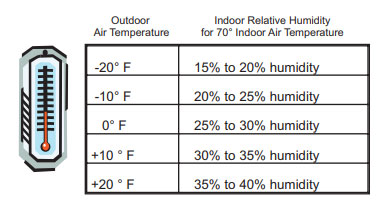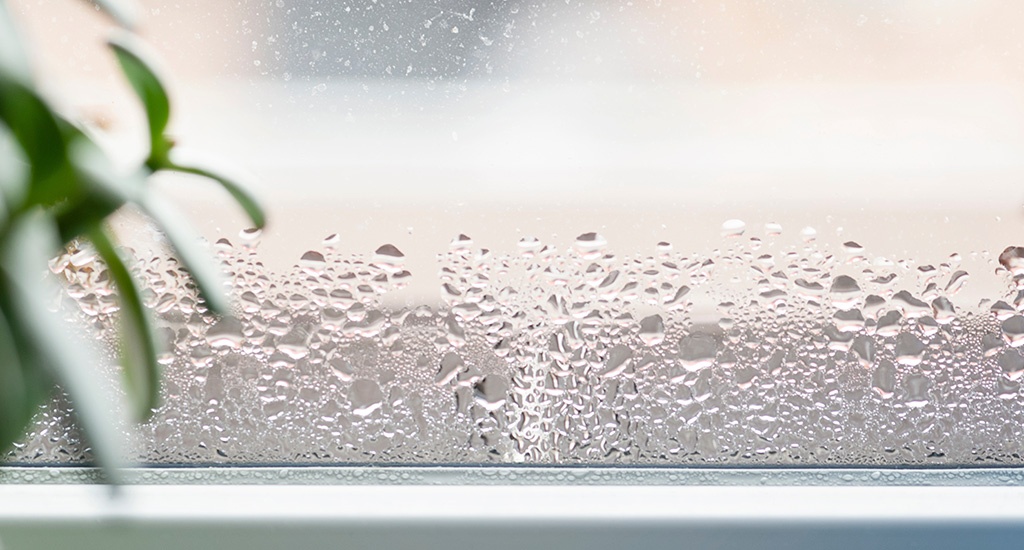The calendar tells us that the fall equinox happened this past weekend, and Mother Nature is starting to let us know that the seasons have changed. The leaves are turning into bright golden hues, sweaters are starting to reappear in our closets again, and pumpkin spice lattes are still a welcome treat. The temperatures are starting to cool and with this change in weather, some homeowners will unfortunately find that they may start being plagued by window condensation.
What Is Window Condensation?
When there is excess moisture in the air, condensation is the result of water changing from a gas (water vapor) to a liquid. Water vapor turns into liquid water when it comes in contact with a cold surface. The warmer the air, the more water vapor the air can hold. In any given room, the air in the center of the room is the warmest. As this air circulates toward the cooler window, the air temperature drops. As the temperature drops, the air can no longer hold all the moisture it held when it was warmer air. That water vapor condenses into liquid water on the glass surface of the door or window.
So Why Does Window Condensation Happen?
Window condensation can be a common issue in many homes, and understanding its causes and potential consequences is important for maintaining a comfortable and healthy living environment. Condensation occurs most often in the winter months as the temperature difference between outdoors and indoors is greater. When the outside temperature starts to fall, more and more homeowners can experience condensation on their windows, even on new, highly efficient multi-pane windows. Fog, frost, and water that forms on windows can be irritating to see, cause expensive damage, and may even be hazardous to your health. Sweating windows serve as a danger signal, showing when indoor moisture is trying to get out.
If condensation is an ongoing issue in your home, you probably have excess moisture in your air. Window condensation is easy to see because it blocks your view. It’s very likely that you have condensation on other surfaces, like your walls and floor. This can lead to serious problems like mold, wood rot, and peeling paint. Condensation can be especially problematic after a remodeling project, as more energy-efficient construction and materials trap moisture inside the home.
It’s important to know why window condensation happens.
Temperature Difference: Condensation occurs when warm, moist indoor air comes into contact with a cold window surface, causing the moisture in the air to condense into water droplets on the glass.
Humidity Levels: High indoor humidity levels, especially during colder months, increase the likelihood of window condensation.
Poor Ventilation: Inadequate ventilation in a room can trap moisture and contribute to condensation.
Energy-Efficient Windows: Energy-efficient windows, which are well-insulated and airtight, may be more prone to condensation because they prevent heat transfer.
Potential Consequences of Window Condensation:
Mold and Mildew: Persistent condensation can lead to the growth of mold and mildew on window frames and sills, which can be harmful to health.
Structural Damage: Over time, excessive condensation can cause damage to wood frames, drywall, and other materials.
Reduced Insulation Effectiveness: Condensation on windows can indicate heat loss, which reduces the overall energy efficiency of your home.
Window Condensation and Your Health: Prolonged exposure to mold and mildew resulting from window condensation can contribute to respiratory issues and allergies. Addressing condensation can help improve indoor air quality and create a healthier living environment.
Recommended Humidity for Your Home and Climate
Some humidity is necessary for everyday comfort, but authorities agree with Professor C.P. Yaglou of the Harvard School of Public Health that any inside relative humidity higher than 40% is undesirable, both for your health and the paint, insulation, and structural members of your home. The table below shows the maximum safe humidity levels for your home.
Reducing humidity in your home to these levels will cure troublesome condensation on windows, in most cases. Remember, too, that these relative humidities are for 70° F indoor air temperatures. For higher temperatures, lower humidities are required.

How to Control Sources of Humidity in Your Home
There are only a few ways to reduce excess humidity in your home. First, providing adequate Winter Ventilation, because outside air usually contains less water vapor, will dilute the humidity of inside air. The process of Heating your home will reduce the relative humidity, providing that it is DRY heat. But the most important step to reducing indoor humidity is Controlling Sources of Humidity.
Heavy Drapes – open drapes at least halfway through the day. Open windows for five minutes to allow air exchange. Here are some of the most common causes of excess moisture in the home and some simple solutions to reduce humidity in your home.
Laundry – equip the laundry area with an exhaust fan. The dryer should vent outdoors.
Dishwashing – vent dishwashers to the outdoors. When washing dishes by hand, don’t leave water running.
Cooking – run the vent hood over the stove. Put lids on pots while cooking.
Showers & Baths – use properly vented exhaust fans during and after showers and baths. Don’t leave the water running to “warm up” for too long.
House Plants – install and use ceiling fans to increase air circulation. Move plants closer to the center of the room.
Damp Basements – turn off humidifiers and run a dehumidifier in the basement. There is often one attached to the furnace.
Cold, Drafty Windows – purchase and install highly efficient Energy Star® rated windows with Low E glass.
Do You Need Replacement Windows, Doors, or Siding for Your Denver Home?
Avoid getting plagued by window condensation this fall and winter! You can trust New Windows for America as your local, family-owned company, replacing windows, doors, and siding in the Denver front-range area. You can trust that New Windows for America will get the job done right.
# # #
New Windows for America is a local and family-owned business for over 25+ years, installs a wide range of energy-efficient windows, doors, and siding. With our trained and professional installers, you can trust New Windows for America as your local window, door, and siding installer to perform a quality installation. We have a 5-star professional and knowledgeable team to help you choose the best windows, siding, and doors for your home, to fit your style, and budget.
Sources:
Vinylmax Windows
Better Business Bureau of Pittsburgh
University of Minnesota Engineering Laboratories
C.P. Yaglou, Harvard School of Public Health
Tim Carter, askthebuilder.com




